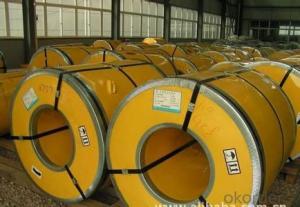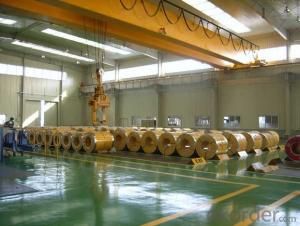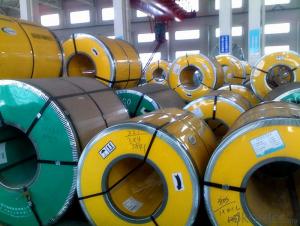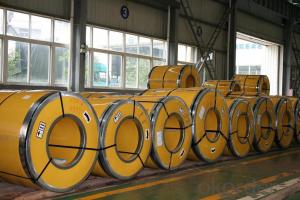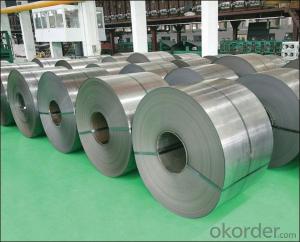Stainless Steel Coil Cold Rolled 201 Half Hard Surface No.2E with Best Quality
- Loading Port:
- Shanghai
- Payment Terms:
- TT OR LC
- Min Order Qty:
- 20 m.t.
- Supply Capability:
- 5000 m.t./month
OKorder Service Pledge
OKorder Financial Service
You Might Also Like
Item specifice
1. Structure of Stainless Steel Coil Cold Rolled 201 Descriptions
Stainless Steel 201 is a new kind of Austenite stainless steel by used Mn, N replace Ni.
The steel has good corrosion resistance and hot / cold processing performance, instead
of 304 stainless steel products for used in the not high of corrosive environment, such as
indoor, inland city outdoor etc.
2. Main Features of the Stainless Steel Coil Cold Rolled 201
Product name: Stainless Steel Coil Cold Rolled 201
Thickness: 0.2mm to 1.5mm
Technical: Cold Rolled
Width: 10mm to 1240mm
Type: 200 Series
Length: As customer's requested
Standard: JIS, SUS, AISI, ASTM
Grade: 201-J1, 201-J4, AISI201, AISI202…
Finish: BA, 2B, 8K, NO.3, NO.4, HL…
MOQ: 25 Metric Tons
Hardness: Low Hard(190 HV Max); Half Hard(240-280HV); Full Hard(42-60 HRC)
Ship Term: FOB any port, China or CFR Destination port
Delivery Time: 15 to 20 day after the receive the deposit or 100%LC
Payment Terms: TT 30% for deposit, Balance against the copy of B/L, or 100%LC
Packaging: By wooden pallet, wooden case or according to customer's request
3. Stainless Steel Coil Cold Rolled 201 Images

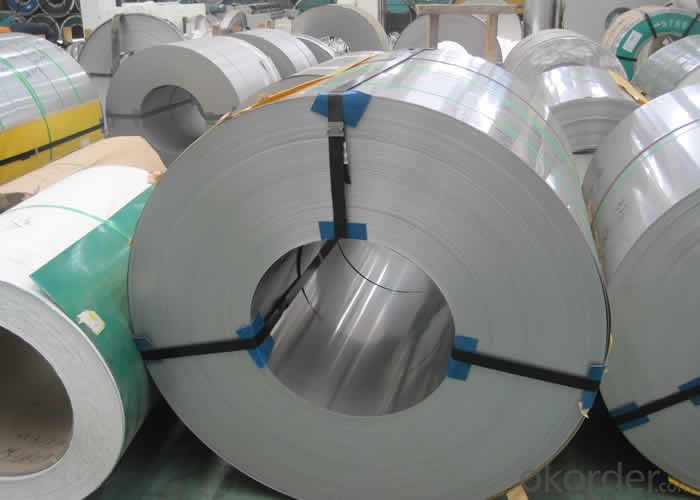
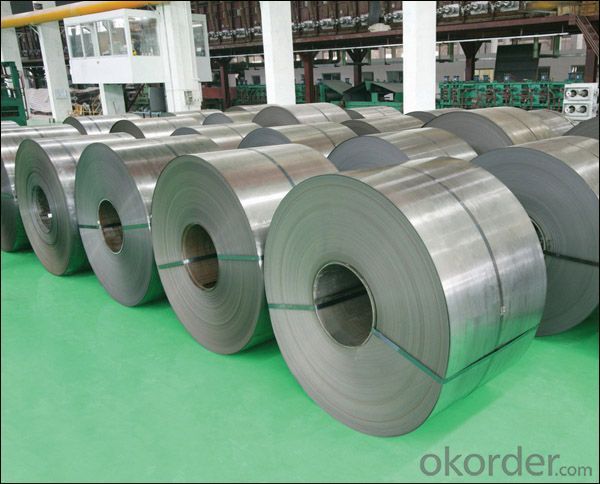
4. Stainless Steel Coil Cold Rolled 201 Specifications
Stainless Steel 200 Series Chemicals Contrast (wt. %) | ||||||||
Chemicals | C | Si | Mn | Cr | Ni | N | Other | |
205 | 0.12-0.25 | ≤0.75 | 14.0-15.0 | 16.5-18.0 | 1.0-1.75 | 0.32-0.4 | ||
JIS, | 201 | ≤0.15 | ≤1.0 | 5.5-7.5 | 16.0-18.0 | 3.5-5.5 | ≤0.25 | - |
201L | ≤0.03 | ≤0.75 | 5.5-7.5 | 16.0-18.0 | 3.5-5.5 | ≤0.25 | - | |
202 | ≤0.15 | ≤1.0 | 7.5-10.0 | 17.0-19.0 | 4.0-6.0 | ≤0.25 | - | |
201LN | ≤0.03 | ≤0.75 | 6.4-7.5 | 16.0-17.5 | 4.0-5.5 | 0.1-0.25 | Cu≤1.0 | |
India | 201-J1 | ≤0.08 | ≤0.75 | 7.0-8.0 | 15.0-17.0 | 4.0-5.0 | ≤0.1 | Cu≤1.5 |
201-J3 | ≤0.08 | ≤0.75 | 9.0-10.5 | 14.0-16.0 | 2.0-3.0 | ≤0.15 | Cu≤2.0 | |
201-J4 | ≤0.10 | ≤0.75 | 8.5-10.0 | 15.0-16.0 | ≤1.2 | ≤0.2 | Cu≤2.0 | |
America | 204 | ≤0.03 | ≤1.0 | 7.0-9.0 | 15.0-17.0 | 1.5-3.0 | 0.15-0.3 | (Cu) |
H400 | ≤0.10 | ≤1.0 | 6.0-9.0 | 17.0-19.5 | ≤3.5 | ≤0.3 | - | |
Japan | YUS130S | 0.09 | 0.5 | 11.0 | 18.0 | 6.5 | 0.35 | - |
NTK S-4 | 0.17 | 0.43 | 14.7 | 17.7 | 1.3 | 0.35 | - | |
NM15M | 0.08 | 0.8 | 14.5 | 17.0 | 4.3 | 0.33 | - | |
Europe America | 219 | ≤0.04 | ≤0.75 | 8.0-10.0 | 19.0-21.5 | 5.5-7.5 | 0.15-0.4 | - |
Cromanite | ≤0.08 | ≤1.0 | 9.5-11.0 | 18.0-20.0 | ≤1.0 | 0.4-0.6 | - | |
201 Surface | Characteristic and Application of Stainless Steel Coil Cold Rolled 201 |
2B | The surface brightness and flatness of 2B is better than 2D then through a special surface treatment to improve its mechanical properties,2B could nearly Satisfy comprehensive uses |
No.4 | Polished with abrasive belt of grit#150#180, have better brightness with discontinuous coarse stria, but thinner than NO.3, are used as bathtub buildings inner and electrical appliances kitchen utensils and food processing. |
BA | Cold rolled, bright annealed and skin-passed, the product have excellent brightness like mirror kitchen apparatus, etc. |
8K | The product have excellent brightness and prefer bright can be the mirror. |
5. FAQ of Stainless Steel Coil Cold Rolled 201
Q: Are you factory or trader?
A: We certainly are stainless steel manufacturer and have processing plant.
Q: Can you provide mill test certificate?
A: Yes! Mill test certificate for both hot rolled raw material coils and cold rolled coils are
available.
Q: Can you make DDQ (Deep drawing quality)?
A: Yes. Our material has been widely used for producing stainless steel pots and stainles
s steel sinks, which have strict request for good deep drawing quality.
Q: How to visit your factory?
A: Most of the main cities in the world have flight to Beijing; you can take flight to Beijing
first, then we will lead you to our Wuxi mills.
Q: How about your company?
A world class manufacturer & supplier of castings forging in stainless steel, is one of the
large-scale professional investment casting production bases in China, consisting of both
casting foundry forging and machining factory. Annually more than 90000 tons Precision
casting and forging parts are exported to markets in Europe, America and Japan. OEM
casting and forging service are available, all according to customer’s requirements.
Q: How to guarantee the quality of the products?
A: We have established the international advanced quality management system,every
link from raw material to final product we have strict quality test; We resolutely put an end
to unqualified products flowing into the market. At the same time, we will provide
necessary follow-up service assurance.
Q: How is the packaging and delivery?
A: Standard export packing (Coil: waterproof paper + protective steel ring; Circle: wooden
box), or as your requirement and the delivery term is based on the project.
Q: How long can we receive the product after purchase?
A: In the purchase of product within 20 working days, we will arrange the factory delivery
as soon as possible. The specific time of receiving is related to the state and position of
customers. Commonly 20 to 40 working days can be served.
- Q:What are the different types of surface patterns for stainless steel strips?
- Stainless steel strips can be adorned with various surface patterns, catering to specific aesthetic and functional preferences. Among the commonly used patterns are: 1. Brushed Finish: This particular pattern involves brushing the steel surface with a fine abrasive material, resulting in a consistent linear pattern. It offers a sleek and sophisticated appearance while reducing the visibility of scratches and fingerprints. 2. Mirror Finish: As the name implies, mirror finish creates a highly reflective and lustrous surface on stainless steel strips. Through meticulous polishing, the steel attains a mirror-like appearance. This pattern is often employed in applications where visual appeal is paramount, such as architectural and decorative elements. 3. Embossed Pattern: Embossed patterns are achieved by pressing or rolling stainless steel strips through a textured roller. This process creates raised designs or textures, enhancing visual appeal and adding a unique touch. Embossed patterns can range from simple geometric shapes to intricate designs. 4. Perforated Pattern: Perforated stainless steel strips feature evenly distributed small holes or perforations on the surface. This pattern not only adds visual interest but also offers functional benefits such as improved ventilation, light diffusion, and acoustic properties. It finds common usage in architectural and industrial applications. 5. Diamond Pattern: Resembling a series of small diamonds, this raised pattern is achieved by embossing the stainless steel strips with a diamond-shaped design. It provides excellent slip resistance, making it suitable for surfaces requiring traction, like walkways, stairs, and industrial flooring. 6. Linen Pattern: Linen pattern imparts a textured surface to stainless steel strips, akin to the appearance and tactile sensation of linen fabric. Achieved by rolling the strips through a patterned roller, it introduces a subtle linear texture. Linen pattern adds visual interest and can help conceal minor surface imperfections. These examples represent only a fraction of the diverse surface patterns that can be applied to stainless steel strips. Each pattern possesses unique characteristics and advantages, enabling a plethora of applications across various industries and settings.
- Q:What are the different types of edges available for stainless steel strips?
- There are several different types of edges available for stainless steel strips, including slit edge, mill edge, deburred edge, rounded edge, and beveled edge.
- Q:What are the different types of stainless steel strip edges?
- There are several types of stainless steel strip edges, including mill edge, slit edge, round edge, deburred edge, and square edge. Each type has a specific purpose and provides a different level of finish and functionality for various applications.
- Q:Can stainless steel strips be used in the mining industry?
- Yes, stainless steel strips can be used in the mining industry. Stainless steel is known for its corrosion resistance and durability, making it suitable for various applications in the mining industry, such as conveyor systems, equipment components, and structural support. Its high strength and resistance to wear, heat, and chemicals make stainless steel strips a reliable choice for mining operations.
- Q:What is the minimum order quantity for stainless steel strips?
- The minimum order quantity for stainless steel strips can vary depending on the supplier or manufacturer. Generally, the minimum order quantity for stainless steel strips can range from a few hundred kilograms to several tons. It is important to note that the minimum order quantity is often determined by factors such as production capacity, material availability, and cost-effectiveness for both the supplier and the buyer. Therefore, it is recommended to contact specific suppliers or manufacturers to inquire about their minimum order quantity for stainless steel strips.
- Q:Are stainless steel strips suitable for dairy equipment?
- Yes, stainless steel strips are suitable for dairy equipment. Stainless steel is a commonly used material in the dairy industry due to its excellent corrosion resistance, hygienic properties, and durability. It is easy to clean, resistant to bacteria growth, and can withstand the harsh conditions typically found in dairy processing. Additionally, stainless steel strips can be easily formed into various shapes and sizes, making them versatile for different dairy equipment applications.
- Q:What are the common uses of stainless steel strips in the petrochemical industry?
- Due to their exceptional qualities and characteristics, stainless steel strips are widely utilized in the petrochemical industry for various applications. In this industry, stainless steel strips find common uses in the following: 1. Heat exchangers: Crucial in petrochemical processes, heat exchangers are often manufactured using stainless steel strips. Their high corrosion resistance ensures the longevity and reliability of the heat exchangers, even in harsh operating conditions. 2. Storage tanks and vessels: Petrochemical plants require storage tanks and vessels to store chemicals and substances. Stainless steel strips are commonly used in constructing these tanks due to their excellent resistance to corrosion, chemical attacks, and high temperatures. 3. Piping systems: Preferred for fabricating piping systems, stainless steel strips provide high strength, corrosion resistance, and the ability to withstand extreme temperatures. This makes them suitable for transporting corrosive and high-pressure fluids. 4. Reactors and pressure vessels: In the petrochemical industry, reactors and pressure vessels are used for various chemical reactions and processes. Stainless steel strips are extensively utilized in constructing these critical equipment due to their durability, resistance to pitting and crevice corrosion, and ability to handle high pressures. 5. Flanges and fittings: Stainless steel strips are commonly employed in producing flanges and fittings used in petrochemical plants. These components require materials that can withstand high-pressure environments and resist corrosion, making stainless steel strips an ideal choice. 6. Instrumentation and control systems: Stainless steel strips are also used in manufacturing instrumentation and control systems in the petrochemical industry. These strips provide excellent dimensional stability, resistance to temperature fluctuations, and resistance to chemical exposure. This ensures the accuracy and reliability of the control systems. Overall, the petrochemical industry extensively relies on stainless steel strips due to their superior corrosion resistance, high strength, heat resistance, and durability. These qualities make them indispensable for critical applications where reliability and longevity are crucial factors.
- Q:What is stainless steel strip?
- Stainless steel strip, a slender and flat piece of stainless steel material, is widely utilized in diverse industries for a multitude of purposes. It is composed of a corrosion-resistant alloy of iron and chromium, with the potential inclusion of elements like nickel or molybdenum. Its smooth and polished surface is attained through hot rolling, cold rolling, or annealing processes. Possessing exceptional strength, durability, and corrosion resistance, stainless steel strip is highly favored in numerous sectors. It is commonly employed in the production of components for kitchen appliances, automotive parts, construction materials, electronic devices, medical equipment, and various other products. Depending on the specific requirements of the application, stainless steel strip can be further processed to obtain different shapes, sizes, or thicknesses, showcasing its versatility. Furthermore, stainless steel strip is available in diverse grades and finishes, each exhibiting distinct properties and characteristics. Austenitic, ferritic, and martensitic grades are classifications within the stainless steel strip category, offering unique attributes such as high temperature resistance, magnetic properties, or enhanced strength. The selection of grade and finish is contingent upon the intended use and the environmental conditions to which the strip will be subjected. To sum up, stainless steel strip is an adaptable and resilient material that serves a myriad of purposes across various industries. Its corrosion resistance, strength, and malleability make it a dependable option for manufacturers in search of high-quality and long-lasting products.
- Q:Can stainless steel strips be used for knife blades?
- Yes, stainless steel strips can be used for knife blades. Stainless steel is a popular choice for knife blades due to its corrosion resistance, durability, and ease of maintenance. Stainless steel strips provide a versatile and cost-effective option for manufacturing knife blades. However, it is important to note that the specific type of stainless steel used and its heat treatment process will greatly affect the blade's performance. Higher quality stainless steel strips with the appropriate hardness and edge retention properties are typically preferred for knife blades.
- Q:Can stainless steel strips be painted?
- Yes, stainless steel strips can be painted. However, it is important to note that stainless steel has a non-porous surface which makes it difficult for paint to adhere properly. To ensure a successful paint job, it is recommended to follow a few steps: 1. Clean the surface: Thoroughly clean the stainless steel strips to remove any dirt, grease, or other contaminants. Use a mild detergent and water, and then rinse and dry the strips completely. 2. Sand the surface: Gently sand the stainless steel strips using fine-grit sandpaper. This will create a rougher surface for the paint to adhere to. Be careful not to damage or scratch the stainless steel while sanding. 3. Apply a primer: Apply a primer specifically designed for metal surfaces. This will help the paint adhere better and provide a smooth base for the topcoat. Make sure to follow the manufacturer's instructions for application and drying time. 4. Paint the strips: Once the primer is dry, apply a high-quality paint suitable for metal surfaces. It is recommended to use a paint that is specifically formulated for stainless steel to ensure better adhesion and durability. Apply the paint using a brush or sprayer, following the manufacturer's instructions for application and drying time. 5. Allow proper drying and curing: Give the painted stainless steel strips enough time to dry and cure fully. This will ensure that the paint adheres properly and provides a long-lasting finish. It is important to note that painted stainless steel strips may require periodic maintenance and touch-ups to maintain their appearance and protect them from corrosion.
1. Manufacturer Overview |
|
|---|---|
| Location | |
| Year Established | |
| Annual Output Value | |
| Main Markets | |
| Company Certifications | |
2. Manufacturer Certificates |
|
|---|---|
| a) Certification Name | |
| Range | |
| Reference | |
| Validity Period | |
3. Manufacturer Capability |
|
|---|---|
| a)Trade Capacity | |
| Nearest Port | |
| Export Percentage | |
| No.of Employees in Trade Department | |
| Language Spoken: | |
| b)Factory Information | |
| Factory Size: | |
| No. of Production Lines | |
| Contract Manufacturing | |
| Product Price Range | |
Send your message to us
Stainless Steel Coil Cold Rolled 201 Half Hard Surface No.2E with Best Quality
- Loading Port:
- Shanghai
- Payment Terms:
- TT OR LC
- Min Order Qty:
- 20 m.t.
- Supply Capability:
- 5000 m.t./month
OKorder Service Pledge
OKorder Financial Service
Similar products
New products
Hot products
Hot Searches
Related keywords
